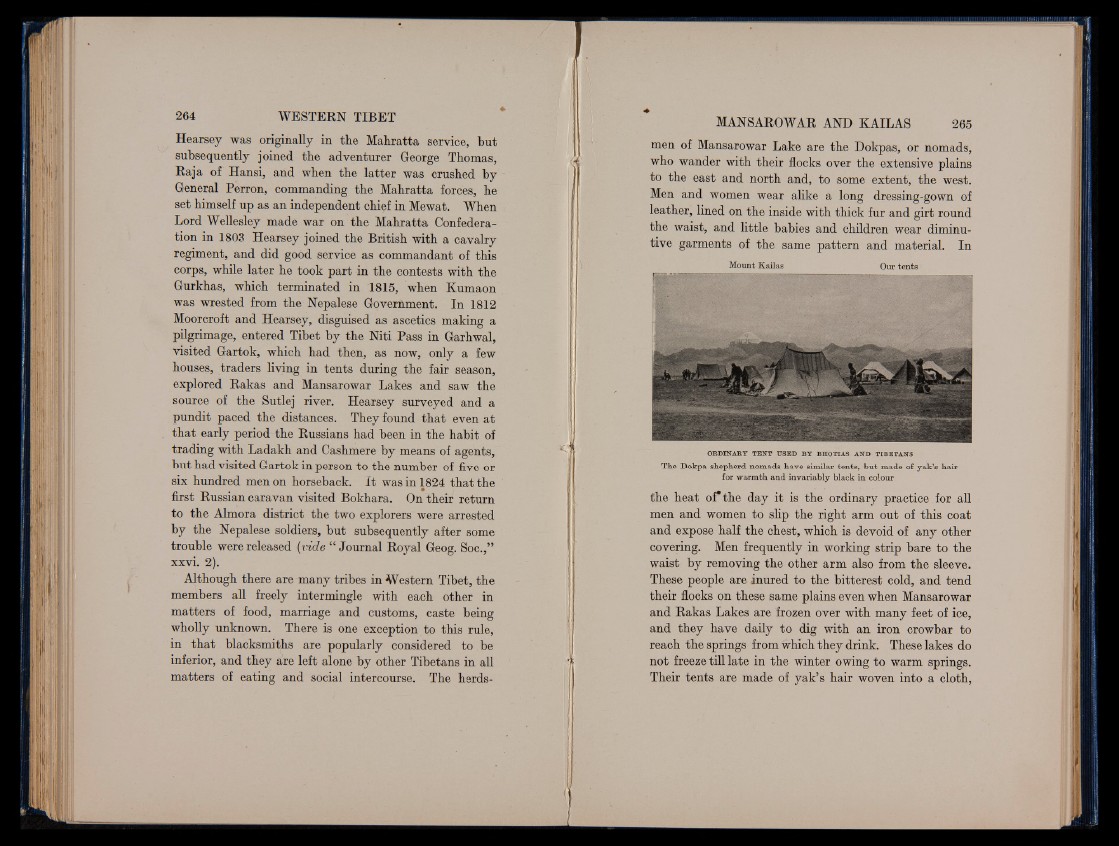
Hearsey was originally in the Mahratta service, but
subsequently joined the adventurer George Thomas,
Raja of Hansi, and when the latter was crushed by
General Perron, commanding the Mahratta forces, he
set himself up as an independent chief in Mewat. When
Lord Wellesley made war on the Mahratta Confederation
in 1803 Hearsey joined the British with a cavalry
regiment, and did good service as commandant of this
corps, while later he took part in the contests with the
Gurkhas, which terminated in 1815, when Kumaon
was wrested from the Nepalese Government. In 1812
Moorcroft and Hearsey, disguised as ascetics making a
pilgrimage, entered Tibet by the Niti Pass in Garhwal,
visited Gartok, which had then, as now, only a few
houses, traders living in tents during the fair season,
explored Rakas and Mansarowar Lakes and saw the
source of the Sutlej river. Hearsey surveyed and a
pundit paced the distances. They found that even at
that early period the Russians had been in the habit of
trading with Ladakh and Cashmere by means of agents,
but had visited Gartok in person to the number of five or
six hundred men on horseback. It was in 1824 that the
first Russian caravan visited Bokhara. On their return
to the Almora district the two explorers were arrested
by the Nepalese soldiers, but subsequently after some
trouble were released (vide “ Journal Royal Geog. Soc.,”
xxvi. 2).
Although there are many tribes in Western Tibet, the
members all freely intermingle with each other in
matters of food, marriage and customs, caste being
wholly unknown. There is one exception to this rule,
in that blacksmiths are popularly considered to be
inferior, and they are left alone by other Tibetans in all
matters of eating and social intercourse. The herdsmen
of Mansarowar Lake are the Dokpas, or nomads,
who wander with their flocks over the extensive plains
to the east and north and, to some extent, the west.
Men and women wear alike a long dressing-gown of
leather, lined on the inside with thick fur and girt round
the waist, and little babies and children wear diminutive
garments of the same pattern and material. In
Mount Kailas Our tents
ORDINARY TENT USED BY BHOTIAS AND TIBETAN3
The Dokpa shepherd nomads have similar tents, but made of yak’s hair
for warmth and invariably black in colour
the heat of* the day it is the ordinary practice for all
men and women to slip the right arm out of this coat
and expose half the chest, which is devoid of any other
covering. Men frequently in working strip bare to the
waist by removing the other arm also from the sleeve.
These people are inured to the bitterest cold, and tend
their flocks on these same plains even when Mansarowar
and Rakas Lakes are frozen over with many feet of ice,
and they have daily to dig with an iron crowbar to
reach the springs from which they drink. These lakes do
not freeze till late in the winter owing to warm springs.
Their tents are made of yak’s hair woven into a cloth,